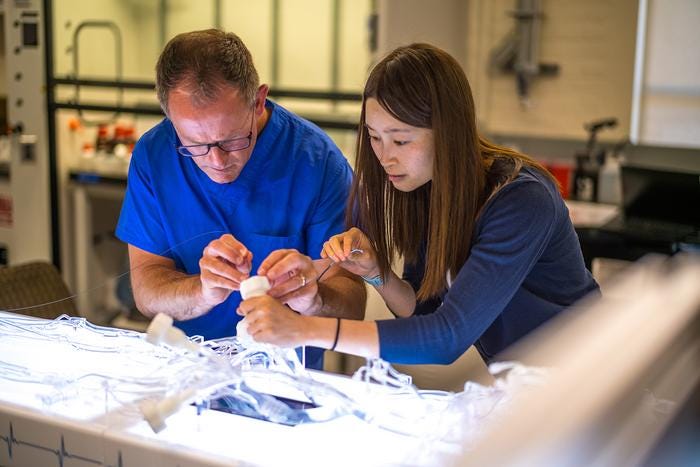Researchers at Stanford University have developed a groundbreaking new device called the milli-spinner thrombectomy that promises to revolutionize the treatment of blood clots. This innovative technology significantly outperforms current methods, offering a much higher success rate in removing life-threatening clots associated with conditions like stroke, heart attack, pulmonary embolism, and peripheral vascular disease.
This is a blood clot:
What you see above is essentially a network of fibrin protein that has trapped red blood cells. Conceptually simple, this is actually a root of many life-threatening conditions that occur when the clots form in arteries of veins. Such conditions include, but are not limited to: Ischemic Stroke -when a clot blocks blood flow to the brain,- heart attacks - when the clot blocks blood to the heart,- and thrombosis -when clots form in major veins and cause pain and swelling. These conditions are globally significant, ranging from thrombosis affecting 900,000 people annually to stroke and embolisms causing sudden death 25% of the time in the people who suffer from them!
Traditionally, doctors have fought clotting via the catheter, which can be a pain to insert, to vacuum/aspirate the clot or to snare and capture it. However, these methods often face significant hurdles:
Low Success Rates: Current technologies only successfully remove clots on the first attempt about 50% of the time.
Complete Failure: In roughly 15% of cases, these methods fail entirely to remove the clot.
Clot Fragmentation: Existing techniques can rupture and fragment clots, leading to pieces breaking off and traveling to other, often harder-to-reach, parts of the body, causing new blockages and poor patient outcomes.
Volume Reduction Limitations: Current devices cannot reduce the size of the clot; they rely on deforming and rupturing it for removal.
Enter the work of Stanford University’s who have developed the milli-spinner. Using this device the new treatment involves a unique and simple mechanical concept to overcome these limitations. Instead of rupturing or cutting the clot, it spins the clot, thus affecting the clot’s structure, compressing the networks tendrils and turning it into smaller denser element that is easier and safer to remove.
Here’s a dramatization:
It’s a clever devision and process:
Like existing methods, we start via a catheter tube.
The device (a long, hollow tube that can rotate rapidly) spins up.
As the tip spins near the clot, it creates localized suction, applying compressing and shearing forces.
It’s like creating a Silly-Putty ball in your palms. The fibrin threads become increasingly tangled into a smaller, denser, intact ball with the trapped red blood cells released.
Once shrunken, the tiny fibrin ball is easily sucked up. The red blood cells? Harmlessly integrated into the bloodstream.
In vitro tests have demonstrated remarkable efficacy with rapid clot reduction, and quickly restored blood flow. This technique really outstrips current aspiration processes, especially when it comes to tougher, fibrin-rich clots that are nearly impossible to treat with current technologies.
It’s really potentially astounding, text success rates are showing more than double current efficacy and with regard to those toughest clots, it can open the artery on the first try 90% of the time, compared to only 11% with existing devices.
The researchers, Jeremy J. Heit and Renee Zhao, are optimistic about the milli-spinner's potential to drastically improve patient outcomes, particularly for ischemic stroke where every minute counts. They have initiated a new company to commercialize this technology, with clinical trials planned for the near future, aiming for swift approval for patient use.
Beyond blood clots, the milli-spinner's localized suction mechanism shows promise for other medical applications, such as capturing and removing kidney stone fragments. This "sea-change technology" represents a promising new direction for mechanical thrombectomy devices and could save countless lives.
Saving countless lives with darling new innovations? That’s good.









You are such a helpful polymath. We’re so lucky to know you.